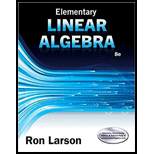Problem 1CR Problem 2CR: Finding an Image and a PreimageIn Exercises 1-6, find a the image of v and b the preimage of w for... Problem 3CR: Finding an Image and a PreimageIn Exercises 1-6, find a the image of v and b the preimage of w for... Problem 4CR Problem 5CR: Finding an Image and a PreimageIn Exercises 1-6, find a the image of v and b the preimage of w for... Problem 6CR Problem 7CR: Linear Transformations and Standard Matrices In Exercises 7-18, determine whether the function is a... Problem 8CR Problem 9CR: Linear Transformations and Standard MatricesIn Exercises 7-18, determine whether the function is a... Problem 10CR: Linear Transformations and Standard MatricesIn Exercises 7-18, determine whether the function is a... Problem 11CR: Linear Transformations and Standard MatricesIn Exercises 7-18, determine whether the function is a... Problem 12CR Problem 13CR: Linear Transformations and Standard MatricesIn Exercises 7-18, determine whether the function is a... Problem 14CR: Linear Transformations and Standard MatricesIn Exercises 7-18, determine whether the function is a... Problem 15CR: Linear Transformations and Standard MatricesIn Exercises 7-18, determine whether the function is a... Problem 16CR Problem 17CR: Linear Transformations and Standard MatricesIn Exercises 7-18, determine whether the function is a... Problem 18CR Problem 19CR: Let T be a linear transformation from R2 into R2 such that T(2,0)=(1,1) and T(0,3)=(3,3). Find... Problem 20CR: Let T be a linear transformation from R3 into R such that T(1,1,1)=1, T(1,1,0)=2 and T(1,0,0)=3.... Problem 21CR: Let T be a linear transformation from R2 into R2 such that T(4,2)=(2,2) and T(3,3)=(3,3). Find... Problem 22CR: Let T be a linear transformation from R2 into R2 such that T(1,1)=(2,3) and T(0,2)=(0,8). Find... Problem 23CR: Linear Transformation Given by a Matrix In Exercises 23-28, define the linear transformation T:RnRm... Problem 24CR: Linear Transformation Given by a Matrix In Exercises 23-28, define the linear transformation T:RnRm... Problem 25CR: Linear Transformation Given by a Matrix In Exercises 23-28, define the linear transformation T:RnRm... Problem 26CR: Linear Transformation Given by a Matrix In Exercises 23-28, define the linear transformation T:RnRm... Problem 27CR: Linear Transformation Given by a Matrix In Exercises 23-28, define the linear transformation T:RnRm... Problem 28CR: Linear Transformation Given by a MatrixIn Exercises 23-28, define the linear transformation T:RnRmby... Problem 29CR: Use the standard matrix for counterclockwise rotation in R2 to rotate the triangle with vertices... Problem 30CR: Rotate the triangle in Exercise 29 counterclockwise 90 about the point (5,3). Graph the triangles.... Problem 31CR: Finding the Kernel and Range In Exercises 31-34, find a ker(T)and b range(T). T:R4R3,... Problem 32CR: Finding the Kernel and Range In Exercises 31-34, find a ker(T)and b range(T). T:R3R3,... Problem 33CR: Finding the Kernel and Range In Exercises 31-34, find a ker(T)and b range(T). T:R3R3,... Problem 34CR: Finding the Kernel and Range In Exercises 31-34, find a ker(T)and b range(T). T:R3R3,... Problem 35CR: Finding the Kernel, Nullity, Range, and Rank In Exercises 35-38, define the linear transformation T... Problem 36CR: Finding the Kernel, Nullity, Range, and Rank In Exercises 35-38, define the linear transformation T... Problem 37CR: Finding the Kernel, Nullity, Range, and Rank In Exercises 35-38, define the linear transformation T... Problem 38CR: Finding the Kernel, Nullity, Range, and Rank In Exercises 35-38, define the linear transformation T... Problem 39CR: For T:R5R3 and nullity(T)=2, find rank(T). Problem 40CR: For T:P5P3 and nullity(T)=4, find rank(T). Problem 41CR: For T:P4R5, and rank (T)=3, find nullity (T). Problem 42CR Problem 43CR Problem 44CR Problem 45CR Problem 46CR Problem 47CR: Finding Standard Matrices for Compositions In Exercises 47 and 48, find the standard matrices for... Problem 48CR Problem 49CR Problem 50CR Problem 51CR: Finding the Inverse of a Linear Transformation In Exercise 49-52, determine whether the linear... Problem 52CR: Finding the Inverse of a Linear Transformation In Exercise 49-52, determine whether the linear... Problem 53CR: One-to-One, Onto, and Invertible Transformations In Exercises 53-56, determine whether the linear... Problem 54CR: One-to-One, Onto, and Invertible Transformations In Exercises 53-56, determine whether the linear... Problem 55CR: One-to-One, Onto, and Invertible Transformations In Exercises 53-56, determine whether the linear... Problem 56CR: One-to-One, Onto, and Invertible Transformations In Exercises 53-56, determine whether the linear... Problem 57CR: Finding the Image Two Ways InExercises 57 and 58, find T(v)by using a the standard and b the matrix... Problem 58CR: Finding the Image Two Ways In Exercises 57 and 58, find T(v)by using a the standard and b the matrix... Problem 59CR: Finding a Matrix for a Linear Transformation In Exercises 59 and 60, find the matrix A for T... Problem 60CR Problem 61CR Problem 62CR Problem 63CR Problem 64CR Problem 65CR Problem 66CR Problem 67CR: Sum of Two Linear Transformations In Exercises 67 and 68, consider the sum S+T of two linear... Problem 68CR Problem 69CR Problem 70CR Problem 71CR: Let V be an inner product space. For a fixed nonzero vector v0 in V, let T:VR be the linear... Problem 72CR: Calculus Let B={1,x,sinx,cosx} be a basis for a subspace W of the space of continuous functions and... Problem 73CR Problem 74CR Problem 75CR Problem 76CR Problem 77CR Problem 78CR Problem 79CR Problem 80CR Problem 81CR Problem 82CR Problem 83CR Problem 84CR Problem 85CR Problem 86CR Problem 87CR Problem 88CR Problem 89CR Problem 90CR Problem 91CR Problem 92CR Problem 93CR Problem 94CR Problem 95CR Problem 96CR Problem 97CR Problem 98CR Problem 99CR: True or False? In Exercises 99-102, determine whether each statement is true or false. If a... Problem 100CR: True or False? In Exercises 99-102, determine whether each statement is true or false. If a... Problem 101CR Problem 102CR format_list_bulleted



 Elementary Linear Algebra (MindTap Course List)AlgebraISBN:9781305658004Author:Ron LarsonPublisher:Cengage Learning
Elementary Linear Algebra (MindTap Course List)AlgebraISBN:9781305658004Author:Ron LarsonPublisher:Cengage Learning

